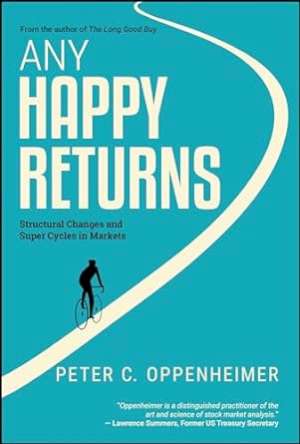21 March 2024
Any Happy Returns
Structural Changes and Super Cycles in Markets
Peter Oppenheier
2023, John Wiley & Sons, 384 pages,
ISBN 9781394210350
Reviewer: Richard Urwin, Chairman of the Investment Committee, Saranac Partners

For all the resources devoted to the analysis of what moves the prices of financial assets over time, many proposed frameworks seem to provide at best only partial insights. The efficient markets approach suggests that market prices on average somehow reflect the true model but is silent on what that true model might be. Risk premia do seem to be part of the story as equity investors, for example, need to be compensated for the relatively high volatility of the asset class’s returns. However, identifying why these risk premia change over time, from either a theoretical or practical perspective, has proved challenging – even after the event.
There are, of course, professionals within the financial services industry who are employed to pontificate on these issues, frequently with some insight. However, much can be lost in the associated self-promotion. The number of analysts who ‘called’ the 2008 crisis seemed to grow rapidly after the event, and even some of those with a genuine claim seem oblivious to the fact that they had spent a disproportionate amount of their careers asserting its inevitability. A stopped clock is right twice a day, but this does not make it accurate.
In this respect, Oppenheimer’s book is a welcome step forward. It is not original in the sense that it brings together many of the ideas he has previously espoused in his long-standing role as an investment strategist, but there is a welcome coherence in seeing these ideas brought together in a book. The main thesis is that history matters. There are cycles in asset prices which in some respects repeat themselves over time. These fluctuations are associated with business cycles, but the relationship is two-way: financial cycles also affect business cycles, as 2008 so clearly demonstrates.
These shorter-term cycles are not, however, the full story. There are longer-term trends which reflect structural changes in economies and the evolving characteristics of the broader societies in which economies are embedded. Importantly, these longer-term factors can be understood even while they are relevant, and do not become apparent only after the event. Financial market performance is determined by these cycles of different lengths and characteristics. However, finance is not everything: a further cycle is the psychological one which in the darkest moments starts in despair, before moving through hope, optimism and, ultimately, irrational exuberance.
There are two particular merits of this book. First, claims which could be left hanging as plausible generalisations are supported with a wealth of background information on a wide range of relevant topics, both historical and more contemporary. This helps not only in understanding the main features of individual cycles but also how they can be seen as a functional collective. Some of the facts are simply interesting in their own right: the 70% increase in Dutch per capita income in the sixteenth century is impressive not just in the context of the time, but also increasingly by contemporary standards. Second, the book is clear and well-written, and can be seen as a helpful primer on a wide range of issues independent of its main theses – demography, geopolitical tensions, globalisation, the role of the state, new technology and inflation to name but a few.
Interested readers will of course be looking for an investable conclusion. What are the characteristics of the prevailing super-cycle? Oppenheimer sees the defining characteristics as higher interest rates, slower trend growth, regionalisation not globalisation, rising relative prices of labour and commodities, rising government debt, changing demographics and higher infrastructure spending. On his view, following the secular bull market which emerged in the aftermath of 2008, we are now in a ‘flat and fat’ environment for equity returns – a wide trading range around an underlying trend which is broadly flat. And presumably, after the material re-rating of global equities in the past six months, we are well into the upper half of this range.
